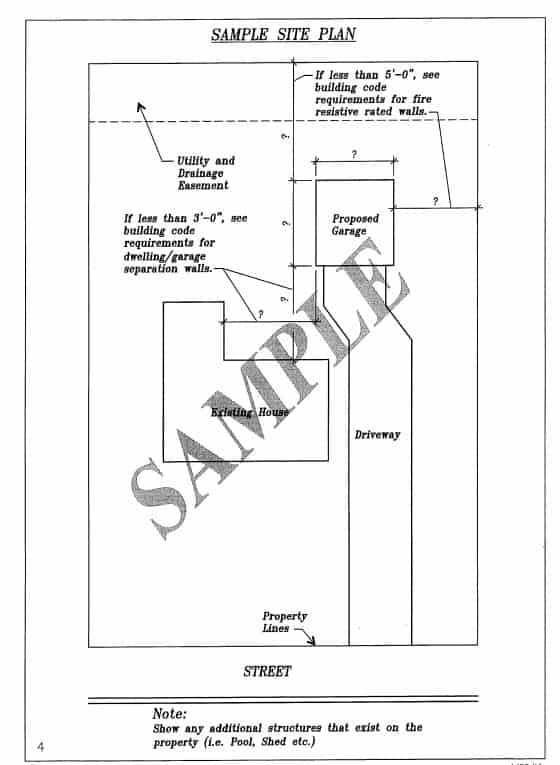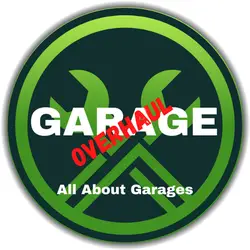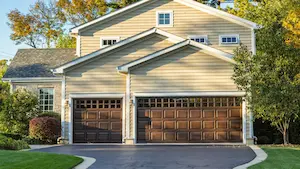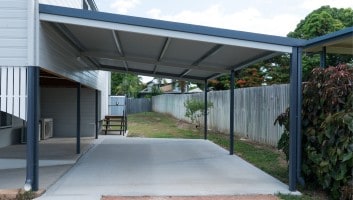Where Should Detached Garage Be Located? (Info and Guidelines)
This post contains affiliate links.
Are you building a detached garage and thinking about the best place for it? There are rules and guidelines, and building codes to consider.
Lay of the land and lot size, among other things, generally rules where the garage fits. Ease of access, the slope of the land, and proximity to neighbors all play a role. You need also consider zoning laws, building codes, guidelines and apply for permits.
Let’s dive in and look for general info and who to contact.
What Zoning Requirements Affect Detached Garages?
Building and zoning departments will enforce the requirements of the zoning ordinances. These requirements depend on your city. Permit submission will be reviewed against the laws.
Accessory buildings like garages, there are setback requirements to follow. All municipalities require additional buildings located a certain distance from the rear, side, and front property lines.
The actual distance depends on the specific municipality and zoning district.
The typical range is 3-5 feet. That’s if because there needs to be clearance between the walls and fence if it exists. There are also fire regulations requiring the walls within 5 feet of the rear or side property line to be fire rated. This means installing fire-code drywall on either side of the frame stud wall that faces the property line.
Garage height is usually restricted to 15 feet. But this differs. Also, the height definition differs from municipality to municipality. So you need to do some detective work.
If you plan to tear down the old detached garage and build a new one on the same spot. The zoning ordinance may not permit that exact same garage position and height to be replicated by the replacement structure.
Your existing garage may be known as “existing non-conforming,” which means that the structure can remain from the municipality standpoint without any requirement to remove it. But once a replacement garage is suggested, that new building needs to comply with all the current requirements of the ordinance and guidelines.
How Far Should a Detached Garage Be From a House?
There are some bureaucracy and places to contact for getting the info.
This REALLY depends on the county, building codes, guidelines, location of utilities, existing sewer lines, zoning, and sometimes HOA(homeowner association.)
Placement should be optimal for the lot and possible breezeway if you construct one.
Minimum distance from the house is 5-10 feet away.
Contact Entities Like:
- Planning, Property and Development Department
- City Zoning Administrator
- Building Inspector
- City Associate Planner
- Building inspection office
For example, guidelines:
- City of White bear lake, Minnesota
- City of Seattle, Washington
- City of New York
- City of Green Bay, Wisconsin
- City of Oakdale. Minnesota
- Jefferson County, Colorado
- San Diego, California
- City of Newton, Massachusetts
- City of Richland, Washington
- Denver, Colorado
- Dayton, Ohio
- City of Dubuque, Iowa
- City of Altoona, Pennsylvania
- Rochester, Minnesota
- Winnipeg, Manitoba
There are too many guidelines, building codes, and regulations in the USA, Canada, and the UK to list ALL of them on this website. So please do some investigation yourself.
You Can Google For:
- Guidelines detached garages and YOUR CITY or COUNTY
- Detached garage requirements and YOUR CITY or COUNTY
- Accessory buildings and YOUR CITY or COUNTY
- Building a detached garage and YOUR CITY or COUNTY
- Zoning regulations and YOUR CITY or COUNTY
- Residential code of YOUR CITY or COUNTY
Check also your city or county website for info.
Usually, it is easiest and fastest to call proper authorities for the most up-to-date info on guidelines and permits.
Contact your Insurance agency and tax office for information on how the new detached garage will affect your yearly costs!
Helpful Links
Upcodes Provides platform for construction codes
R1/ R2 / R3 Zoning Guidelines for Houses, Garages, and Sheds
Here are some EXAMPLE tips that explain the zoning guidelines to help you build a new house, garage, or storage shed. Add onto your home with porch, deck, garage, carport, or new room, or add onto your garage or storage shed.
What is Zoning?
Zoning is a set of guidelines that tell you what you can use your property for and where you can build on your lot.
Zoning is commonly exercised by local governments such as counties or municipalities. However, the state determines the nature of the zoning scheme with a zoning enabling law.
Why Do We Have Zoning?
To promote sound, safe, healthy, and desirable community; To encourage good development and support the conscientious developer; To protect existing property values and uses while providing for future generations.
How Big Can I Build My House or Garage?
Your house-including porches, decks, and attached or detached garages- can be up 40% of the size of your lot.
First, measure the outside dimensions (Length x Width) of your house (include any porch, deck, carport, or garage) and any detached buildings not connected to the house. This gives you the area or square footage of your home and garage.
Now compare it to the size of your lot. For example, you could have up to 2,400 square feet of house and garage on the ground level with a 60 by 100-foot lot (0,40x60x100=2,400)
Any detached garage (not connected to the house) must be smaller in square footage than the house and no larger than 1,000 square feet.
How High Can My House or Garage Be?
Your house can be up to 30 feet high, and any detached garage can be up to 15 feet tall. Measure from the ground to halfway between the top of the walls and the peak of the roof. (Measurement rules vary from county to county.)
How Close to Property Lines Can I Build My House or Garage?
First, you need to locate your property lines. Property lines may be marked by metal pins, stakes, or similar markers. Front property lines generally are 10 feet from the back of the street curb.
Property lines do not necessarily follow the sidewalk, curb, or fence line. Suppose you cannot find your property lines or are uncertain about their location. In that case, you may want to have your property surveyed.
You can find licensed surveyors listed in the “yellow pages” or search online ” Land surveyors.”
Along any street, your house generally should be at least 30 feet but no more than 60 feet from the back of the curb. If your garage faces the road, it should be 30 feet from the back of the curb.
Corner lots and through lots (having streets in front and back) have to meet these guidelines along both streets. In the back yard or along an alley, your house and all attached garages must be set back from the property line a distance of at least 20 feet.
Source City of Dubuque
Can I Build a Garage to Boundary?
Typically you can build very near the boundary, but there needs to be some room for movement around the structure and fence if there is one.
Accessory buildings like garages, there are setback requirements to follow. All municipalities require additional buildings located a certain distance from the rear, side, and front property lines. The actual distance depends on the specific city and zoning district.
Accessory structures like a detached garage or shed required a minimum 5-6 foot setback from your side and/or rear property lines. If your property is on a corner, a 10-foot setback will be required for accessory structures.
A detached garage, however, can be 6 feet from the rear property line. Along the sides of your lot, your house and garage generally should be at least 6 feet from the property line. Corner lots and through lots must meet this guideline on the 2 sides of the lot that are not along the street.
Source City of Dubuque.
Can My Neighbour Stop Me Building a Garage?
Your neighbors can’t stop you from making changes to your property that are within the law, but they can, in some cases, affect when and how the construction is carried out.
If your neighbors have some concerns, it’s best to sit down with them and show them your plans. You can and should also get a legal opinion if your neighbors refuse to meet you and discuss their concerns.
Do I Need Planning Permission for a Detached Garage?
Usually, you need a permit. This depends on the structure.
Permits are obtained by submitting the required information to entities like:
- Planning, Property and Development Department
- City Zoning Administrator
- Building Inspector
- City Associate Planner
- Building inspection office
You cannot rely on sidewalks, laneways, or fences to determine where your property line is located. The only accurate way to determine your property line is Surveyors Staking Certificate.
Suppose you do not have a copy of this certificate. In that case, you may need to retain the services of a qualified Land Surveyor – this is the best way to avoid property boundary disputes with neighbors.
Usually, you need a permit. Apply process example:
- Application Form.
Usually available online and places like building inspection office.
2.Site Plan/Plat of Survey
A site plan showing property lines, the nearest streets, lot dimensions, existing structures (house, garage, shed, etc.) with dimensions and distances from the property lines. Indicate the location for the garage or accessory structure on the site plan.
3.Lot Dimensions
Contact the Zoning Administrator (or similar entity) to determine what distance the accessory structure must be from property lines. Search for lot dimensions from the county’s website.
4.Detailed Drawings
The drawings should show
- A floor plan
- A typical wall section
- Foundation details
- Wall bracing details
- Roof details, and
- Electrical details
5.Submit the Permit Application and Drawings.
They will be reviewed for compliance with zoning requirements and residential codes.
6.Permit Issuance
7.Electrical Permit
A separate permit for electrical work must be obtained if the project includes extending electrical power to the structure.
Inspections During Construction
There are several steps in the construction of a garage or accessory structure that require inspection.
1. Footing Inspection – The first inspection must occur after excavating for the footings, the forms are set, and before any concrete is poured. This allows the depth, size, and layout of the foundation to be confirmed.
2. Electrical Rough-in Inspection – This inspection confirms the National Electric Code requirements are being met and is conducted before the framing inspection and before installing fixtures or appliances.
3. Framing Inspection – The third inspection must take place before any interior finishes being installed. This allows the beams, joints, ledger, lateral load connection, and connections to be confirmed. The roofing system (sheathing, underlayment, and shingles) can be installed before this inspection.
4. Final Inspections – When the siding, doors, windows, fixtures, and other finish items have been completed, the final inspection must be successfully completed before the structure can be put into use for its intended purpose.
Source City of Dayton
Do I Need a Plat of Survey to Build a Detached Garage?
What is a plat of survey or site plan?
Plat of survey is required as a part of the permission submission in many regions. Plat of survey helps identify any structure and specific points, details, or circumstances of your lot. And the relationship of any structure to the property lines and neighboring homes and structures.
Plat of survey is extremely helpful to determine any issues with clearance to any structure. It should have the correct dimensions to scale with any paths, driveways, walks or decks, and accessory structures like sheds. It should have all that is located on the ground of the property. (Trees are usually not a requirement, but they are helpful.)

The survey needs to clearly identify the residence and the garage with their respective setbacks(I.e., The measurement from a property line) with legal description included.
If your home paperwork does not include the survey. You can order one from a local surveyor.
Detached Garage in Front of the House
There are many opinions of the location of the garage and the house. Still, the garage is a secondary structure and should not draw attention out of the house.
Detached garages may be located only in the side and rear yards in most regions.
Detached Garage Behind the House
A common requirement of the zoning codes is that the garage is a secondary structure. So you need to consider the relationship between the house, street, and the garage. So setting the garage back or the side yards is usually the easiest thing to do. In addition to setting the garage back, you should reduce the visual impact of the driveway by decreasing the width of the pavement and using landscaping.
- For a single-car garage, the driveway should be 10-14 feet wide.
- For a two-car garage, the driveway should be 20-24 feet wide.
- Consider if you need turn space in front of the garage and leave enough room for turning the car around.
Use breezeways, paths, and trellis between the garage and house to not isolate the garage entirely from the house.
The design of the garage should draw from the style of the house. The garage should have the same roof shape, slope, and trim details as the house.






